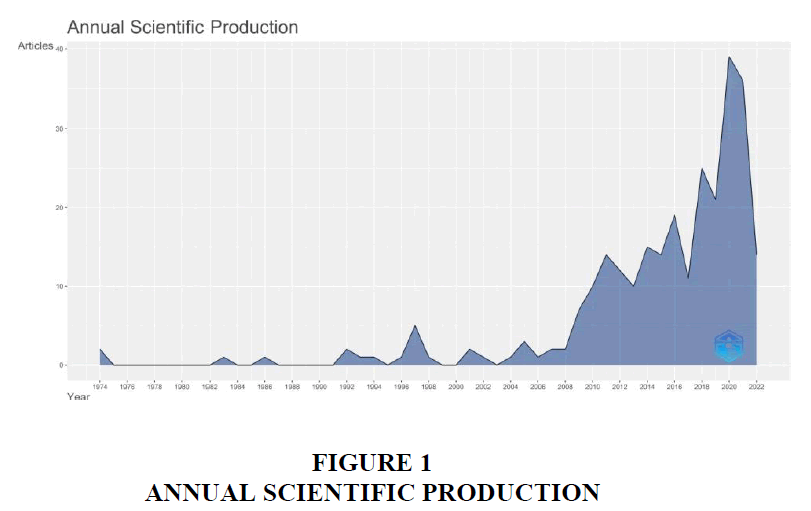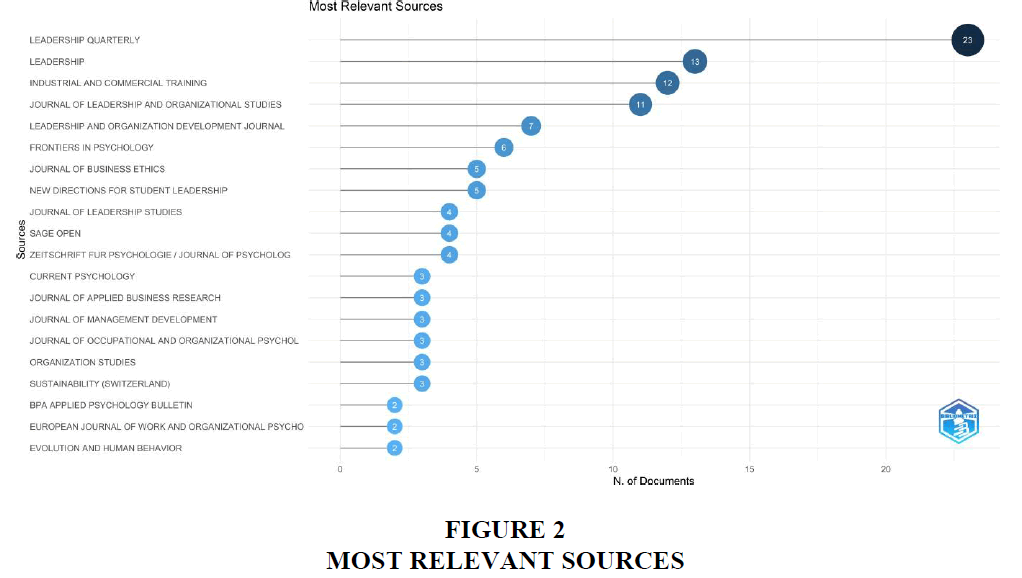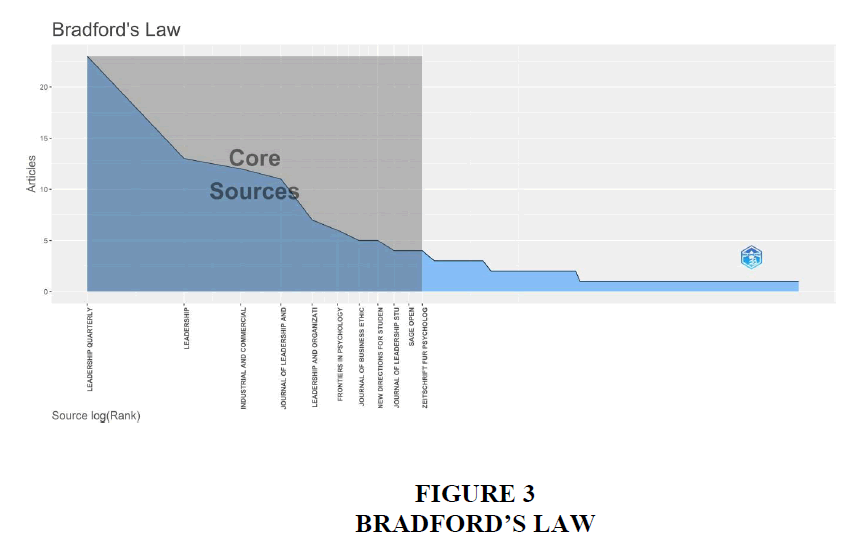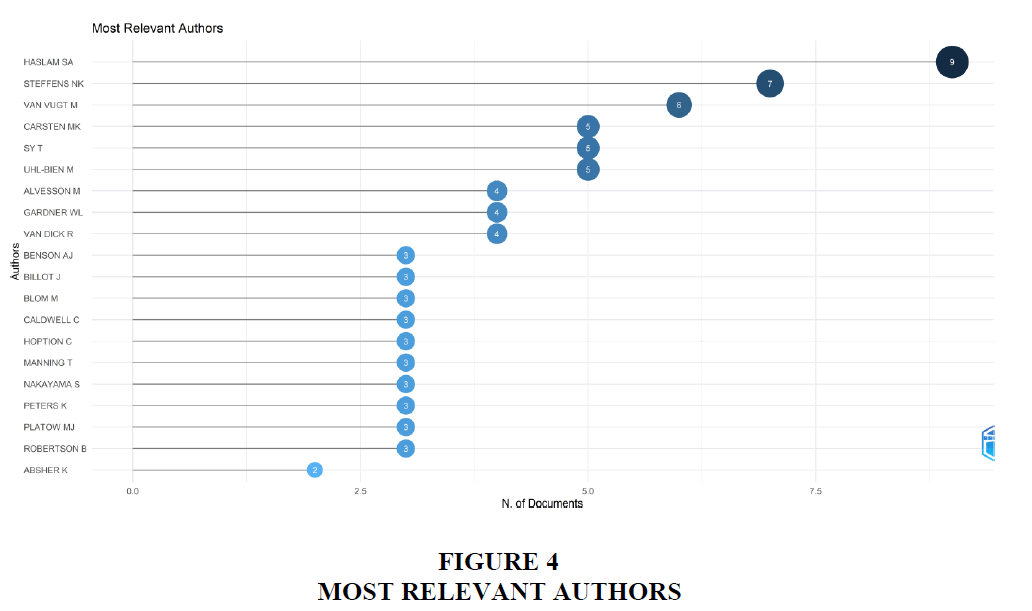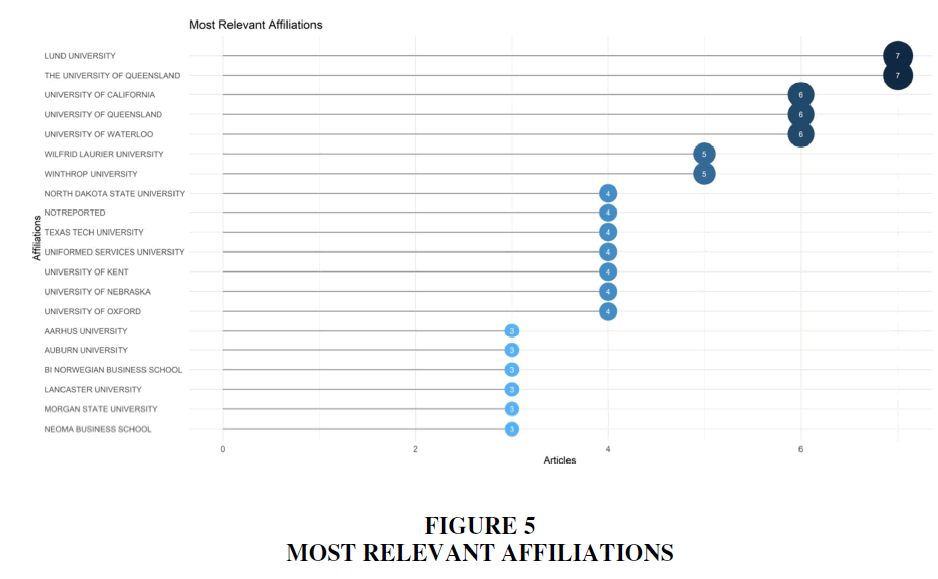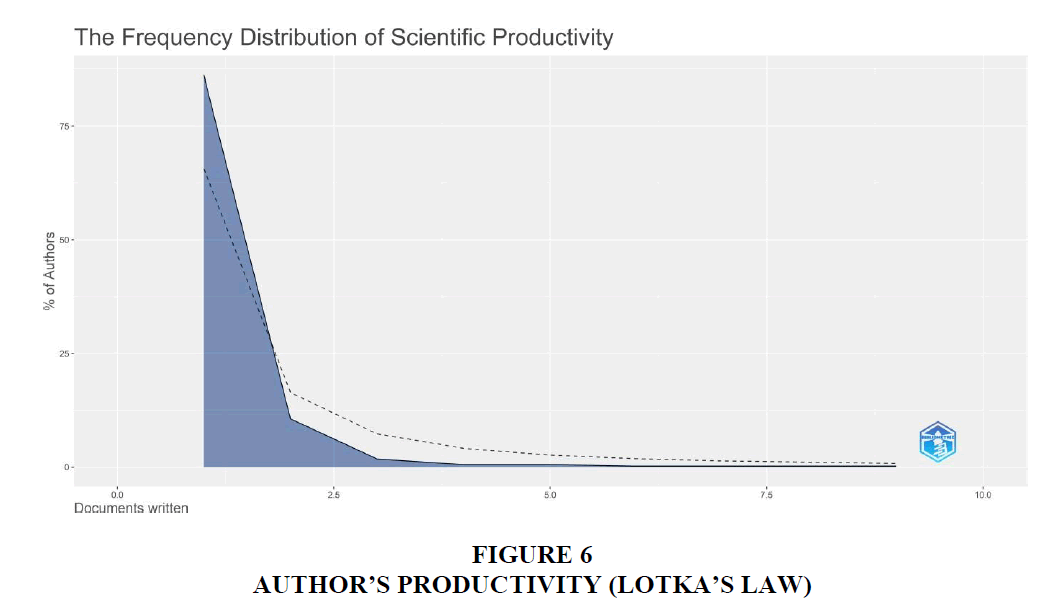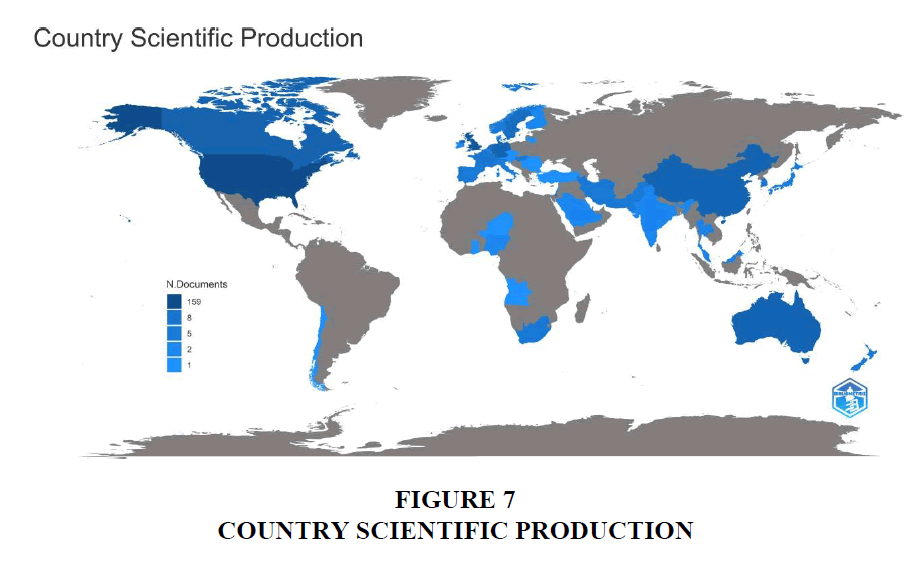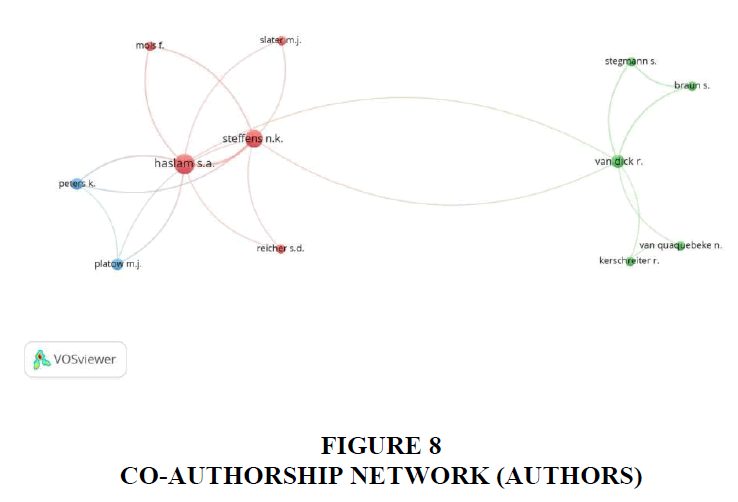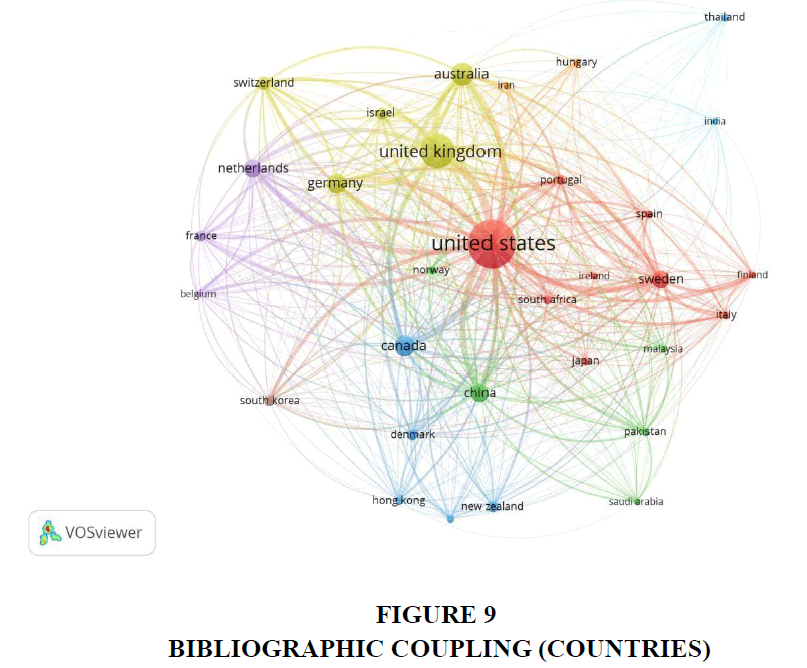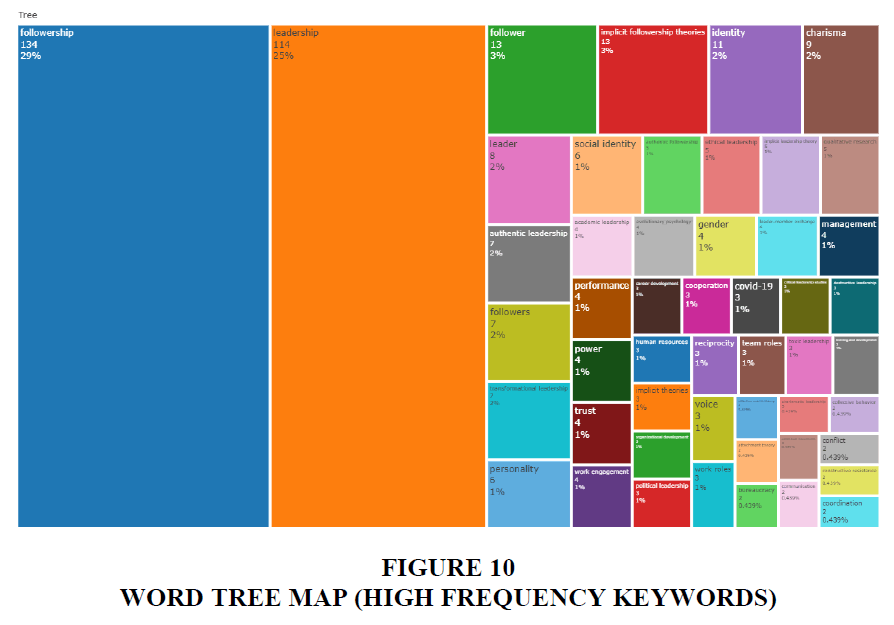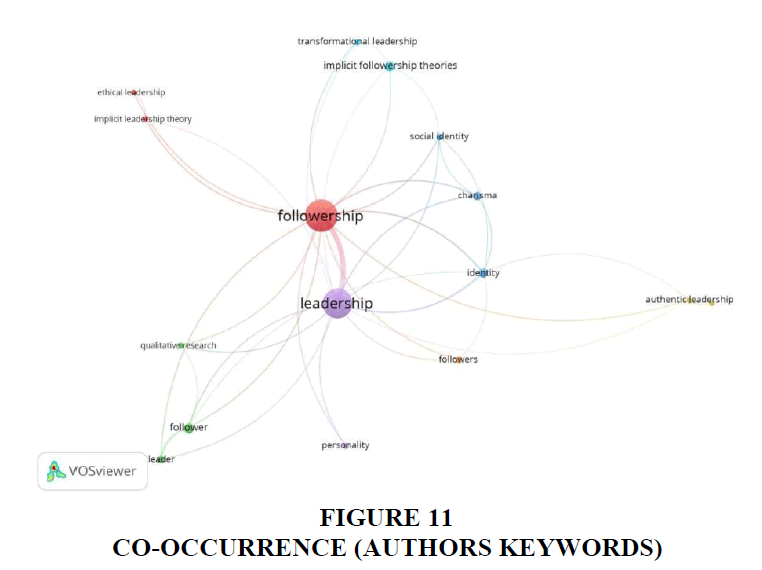Review Article: 2023 Vol: 27 Issue: 2
Revisiting Followership through Bibliometric and Content Analysis
Shubhangi Sharma, IMS Unison University
Amit Adlakha, IMS Unison University
Shikha Rana, IMS Unison University
Citation Information: Sharma, S.,Adlakha, A., & Rana, S.(2023). Revisiting followership through bibliometric and content analysis. Academy of Marketing Studies Journal, 27(2), 1-20.
Abstract
Followership an aspect of leadership is gaining its significance in longer run of Organizations. Research in this arena is eminently promising for the development of intriguing theory and impactful policy implications. The domain of followership lacks a bibliometric analysis of literature representing the bibliographic information of the field in an accurate and systematic way. Consequently, this paper‘s overarching aim is to present the bibliographic information of followership showcasing performance matrix of different constituents and analysing their association with each other pertaining to the followership area. This study used bibliometric analysis methodology through performance analysis and science mapping using biblioshiny, an R tool and VOSviewer software. The analysis showcased the most prolific contributors in the literature so far and presented the relationship of the constituents through bibliographic coupling and clustering. Seven thematic clusters were formed identifying the emerging themes in the area of followership.
Keywords
Followership, Leadership, Servant Leaders and Followers.
Introduction
Creativity, as has been said, consists largely of rearranging what we know in order to find out what we do not know. Hence, to think creatively, we must be able to look afresh at what we normally take for granted.? George Kneller
The world perceive Bill Gates, Elon Mask, Steve Jobs and numerous other modern industrialists those have revolutionized world with their acclaimed developments like PCs, Tesla engines, Space X, Apple I-telephone and Mac Book. Aside from modern leaders the world likewise commends Mahatma Gandhi, Mother Teresa, Helen Keller who were philanthropists and social leaders of their time. Be that as it may, there raise a question: what makes them extraordinary leaders other than their own characteristics like innovativeness, vision, and desire? To address this question Riggio, et al. (2008) contended that paying little mind to who is recognized as founder, no organization or country is built without the consolidated exertion of unnoticed yet passionate group of followers. The servant leader style is to assure that "others' most prioritized needs are being served;" this leader " tends to be more successful and refine his ideology on what serves another's most noteworthy needs than is the individual who is leader first and who later serves out of promptings of conscience, or in similarity with standardizing assumptions" (Greenleaf, 1970). Many academicians and practitioners confess that there is no leadership without followership. We realize that behind the success of Tesla, Microsoft and Apple there is extensive and on-going endeavours of numerous individuals. Despite such importance of followership, it has been ignored while directing research on leadership sin the past and the reason is followership has been associated to disparaging and negative connotation like weak, passive and conforming. The other reason is the misinterpretation that followership is less significant than leadership (Bjugstad, Thach, Thompson, and Morris, 2006). As of late, different academicians are deciding to work on followership since Kelley's (1988) article, "In Praise of Followers" published in the Harvard Business Review and Challeff?s (1995) book about valiant followers got perceived. As per Fairhurst and Uhl-Bien, (2012) the course of leadership is co- made by the relational and social connections between people. Followership is enormously obligatory for leadership, as it is one of a part of it.
Literature Review
The primary focus of servant leader remains on his/her followers. Leaders and followers cannot exist without each other. Van Dierendonck (2011) claims that the intent of a servant leader is to look after followers‘ growth. Though, servant leaders feel responsible for serving all organizational stakeholders, but primarily their followers, trusting that they will do what is best for the organization and its constituents (Stone, Russell, & Patterson, 2004). The main difference between servant leadership and different sorts of leadership is the inspiration or will within servant leadership to serve others so that both the leader and follower live up to their true capacity. Ehrhart (2004) stated that "The way of behaving that servant-leaders model incorporates 'serving' their employees by generating quality relationships with them and motivating them to grow and develop. In this way, work-units with servant-leaders ought to have individuals who will imitate this way of behaving. Carsten, Bien, West, Patera, and McGregor (2010) developed the Implicit Followership Scales (IFS) to quantify latent and proactive followership as responses connected with status furthermore, social development of reality relying upon styles of leadership and organizational culture. These researchers affirm that passive followership is many times a response to authoritarian leaders in administrative environments. Proactive followership is most frequently a reaction to supportive or shared leadership in empowered environments. Parolini (2005) identified follower perception of supervisor leadership behaviours was a profoundly huge indicator of perception of servant leadership culture. Importantly, as employees perceived superiors "to serve, empower and project vision to them" they were bound to experience the organization as servant led. As leaders looked after interests of the followers and organization over their very own advantage, a mutual sharing of responsibility and power with followers was facilitated, including developing follower feedback as part of improving organizational vision. Adding more to it, it is likely that followers perceived the leader and culture as servant oriented "through valuing and developing individuals, building relational and authentic community, and giving and sharing leadership." "Kelley (1988) stated that for the success of any organisation followership is equally important as of leadership. Chaleff (1995) in his book about ?courageous followers‘ also claimed that followers are non-passive subordinates of the organization. Thus it has been known for a long time that followership and followers are important components of leadership. Research into leadership can be divided into three stages (Haslam, 2004). The first was characterized by a search for the distinctive intellectual and social qualities (e.g., knowledge, great judgment, understanding and innovative mind) which set leaders apart from followers and which make them innately more skilled at coordinating, impacting and moving others. These days such theories have not many scholastic followers. There is basically no dependable proof of any characteristics which either recognize leaders from non-leaders or which anticipate leadership viability (e.g., Jenkins, 1947; Mann, 1959; Nadler and Tushman, 1990; Sherif and Sherif, 1953; Steiner, 1972; Stogdill, 1948). In any case, regardless of whether one can't recognize leaders by their characters, there is better proof that it very well might be feasible to do as such by their actions. For example, Fleishman et al. (Fleishman, 1953; Fleishman and Peters, 1962, see likewise Bowers and Seashore, 1966) showed that compelling leaders display (a) thought for the interests and government assistance of followers and (b) structure initiation — that is, an ability to structure the exercises of followers with the end goal of accomplishing bunch objectives (Reicher, S. et. al., 2005). However, countless researches on leadership in authoritative investigations (Yukl, 2012), immaterial consideration has been paid to followership (Bligh, 2011; Carsten et al., 2010; Kelley, 2008; Sy, 2010). The investigation of followers is striking in the leadership process, followership has been generally missed in the literature of leadership. As indicated by Uhl-Bien et al., (2014) the justification for distractedness towards followership could be because of misinterpretations about its development and the way in which they relate with leadership. The presence of this misinterpretation is a result of the course of leadership is hazy to the vast majority of us that is co- made in relational and social associations among individuals (Fairhurst and Uhl-Bien, 2012). "On the off chance that leadership includes effectively impacting others, followership includes permitting oneself to be affected" (Uhl-Bien and Pillai, 2007).Additionally, nowadays the concept of followership has become significant to both the academicians and practitioners with shared and distributed leadership where individuals play the role of both a leader and a follower at the same time (Crossman & Crossman, 2011; Horsfall, 2001). There is a truth here which is so obvious that it is easy to overlook. Leadership is not simply a matter of leaders, or even of leaders and followers. Rather it has to do with the relationship between leaders and followers within a social group (Haslam, 2001; Sherif, 1962; van Knippenberg & Hogg, 2003).
Research Objectives
With the changing dynamics of leadership models and styles in organizational context, the significance of shared leadership where a leader intends to invest in his employees selflessly and in return the employees turn into followers of their leader. Regardless of multiple studies published on leadership, the prominence of followership still remains underexplored. In response to it, this study aims to-
1. To identify the most prolific contributing constituents (annual scientific production, sources, authors, affiliations, countries, author‘s productivity and country scientific production) in the literature of followership so far.
2. To depict the relationship among the identified contributing constituents (co-authorship, bibliographic coupling and co-occurrence or co-word analysis) in followership domain.
3. To analyse the thematic trend or emerging areas in the field of followership.
Method
In this study, a bibliographic mapping analysis was conducted. Bibliometric analysis is recently gaining more grounds in different disciplines (Aria & Cuccurullo, 2017; Arici et al., 2019; Song et al., 2019). The entire procedure for conducting bibliometric analysis including data collection, screening, extraction, and synthesis are presented in this section. The bibliometric techniques used for analysis are performance analysis and science mapping. Performance analysis is done through biblioshiny, an R tool and science mapping is done using VOSviewer.
Literature Search and Data collection
Primarily, a document search was conducted on SCOPUS database. The search string consists of a combination of compound keywords concatenated with the OR and AND operator. In the first search field the keyword ?followership? was searched while for the second search the keywords ?followers AND leaders? were searched. Initially the search query retained 350 total articles without applying any filter. The search and data retrieval was done on May 12, 2022. Afterwards to refine the data some filters were applied following the inclusion and exclusion criteria. The inclusion and exclusion criteria performed as follows in the search string. TITLE-ABS-KEY (?followership?) OR TITLE- ABS-KEY(?followers* leaders?) AND (LIMIT- TO (DOCTYPE, ?articles?)) AND (LIMIT-TO (SRCTYPE, ?journal?)) AND (LIMIT- TO (LANGUAGE, ?English?)), following to which a total of 274 articles were retrieved and further the bibliometric analysis was conducted on that data to draw interpretations.
Bibliometric Analysis and Software Package
The techniques for bibliometric analysis are categorised under these: (1) performance analysis and (2) science mapping. Basically, performance analysis represents the contributing constituents of research, while science mapping focus on the associations between research constituents (Donthu et. al, 2021). For performance analysis the study used Biblioshiny, bibliometrix R-package software , an open source software that provides a set of tools for conducting quantitative research in bibliometrics through identifying annual scientific production, most relevant sources, bradford‘s law (sources), most relevant authors, country scientific production and author‘s productivity using Lotka‘s law. Science mapping is done through VOS-viewer 1.6.17 by analysing co-authorship, co-occurrence and bibliographic coupling of clusters.
Results and Analysis
Through SCOPUS database a total number of articles retrieved were 350. The data was further sorted on the basis of years (1974- 2022), document type (Articles), source type (Journals) and Language (English) resulted in 274 articles. After data extraction the data was run through Biblioshiny, an R- tool and VOSviewer for bibliometric analysis. The results generated by biblioshiny are enclosed further in the research paper.
Analysis
The bibliometric analysis is done through two techniques performance analysis and science mapping. The findings retained are described and presented below.
Performance Analysis
Performance analysis assesses the contributions of research constituents to a given field (Cobo, Lopez-Herrera, ´ Herrera-Viedma, and Herrera,2011; Ramos-Rodrígue and Ruíz-Navarro, 2004). The analysis, which is descriptive in nature, is the sign of bibliometric studies (Donthu, Reinartz, Kumar, and Pattnaik, 2020). Performance analysis can be found in many researches, even in those that don't participate in science mapping, since it is a standard practice in researches to highlight the performance of different research constituents (e.g., authors, institutions, nations, and journals) in the field, which is similar to the foundation or profile of participants that is normally introduced in empirical research but more analytically.
Main Information data
Table 1 depicts the main information of the data retained through SCOPUS database. It was run through biblioshiny which provided the overall information of total sources, total documents, document types, document contents, authors and authors‘collaboration.
| S.NO | Description | Results |
| 1 | MAIN INFORMATION ABOUT DATA | |
| 2 | Timespan | 1974:2022 |
| 3 | Sources (Journals, Books, etc) | 163 |
| 4 | Documents | 274 |
| 5 | Average years from publication | 6.96 |
| 6 | Average citations per documents | 23.7 |
| 7 | Average citations per year per doc | 2.287 |
| 8 | References | 15837 |
| 9 | DOCUMENT TYPES | |
| 10 | article | 274 |
| 11 | DOCUMENT CONTENTS | |
| 12 | Keywords Plus (ID) | 455 |
| 13 | Author's Keywords (DE) | 659 |
| 14 | Authors | 566 |
| 15 | Author Appearances | 686 |
| 16 | Authors of single-authored documents | 66 |
| 17 | Authors of multi-authored documents | 500 |
| 18 | AUTHORS COLLABORATION | |
| 19 | Single-authored documents | 71 |
| 20 | Documents per Author | 0.484 |
| 21 | Authors per Document | 2.07 |
| 22 | Co-Authors per Documents | 2.5 |
| 23 | Collaboration Index | 2.46 |
Annual Scientific Production
Through figure 1 it can be interpreted that the annual scientific production was almost negligible in the foremost phase. The growth can be seen in the production in early 20‘s after which the growth rate has a positive graph indicating relevant research in the area. The huge curve was noticed in year 2021, making it the most promising year in the literature of followership.
Performance Analysis
Through figure 1 it can be interpreted that the annual scientific production was almost negligible in the foremost phase. The growth can be seen in the production in early 20‘s after which the growth rate has a positive graph indicating relevant research in the area. The huge curve was seen in the year 2021, making it the most promising year in the literature of followership.
Most Relevant Sources
Figure 2 showcases that ?leadership quarterly‘ has published the maximum number of documents (23) making it the most relevant source (journal) in the field. After which ?leadership‘ with total (13) published documents is the second most relevant source (journal) in this area. ?Industrial and commercial training‘ following the trend with total (12) documents is the third major source.
Figure 2 showcases that ?leadership quarterly‘ has published the maximum number of documents (23) making it the most relevant source (journal) in the field. After which ?leadership‘ with total (13) published documents is the second most relevant source (journal) in this area. ?Industrial and commercial training‘ following the trend with total (12) documents is the third major source.
Bradford’s Law
Bradford's Law is an example previously depicted by Samuel C. Bradford in 1934 that gauges the exponentially diminishing returns of searching for references in science journals.
Figure 3 describes the bradford‘s implied graph dividing the sources (journals) into three zones, where zone 1 is the core zone having the most acknowledged sources, zone 2 with moderately relevant sources and zone 3 with less impactful sources. Out of 163 sources, zone 1 reported (1-11) sources, zone 2 included (12 – 73) sources and lastly (74- 163) sources were included in zone 3.
Journals in a field can be divided into three parts, each with about one-third of all articles: 1) a core of a few journals, 2) a second zone, with more journals, and 3) a third zone, with the bulk of journals. The number of journals is 1:n:n2.
Core sources – 11 zone 1, zone 2 (12-73) and zone 3 (74- 163)
Figure 3 describes the bradford‘s implied graph dividing the sources (journals) into three zones, where zone 1 is the core zone having the most acknowledged sources, zone 2 with moderately relevant sources and zone 3 with less impactful sources. Out of 163 sources, zone 1 reported (1-11) sources, zone 2 included (12 – 73) sources and lastly (74- 163) sources were included in zone 3.
Most Relevant Authors
Figure 4 states the most relevant authors in the field of followership, where top 20 authors were recorded. Out of those ?Haslam SA‘has the most prominent number of documents (9) published following him ?Steffens NK‘ (7) and ?Van Vugt M‘ (6) are the other major contributing authors in the arena.
Figure 4 states the most relevant authors in the field of followership, where top 20 authors were recorded. Out of those ?Haslam SA‘ has the most prominent number of documents (9) published following him ?Steffens NK‘ (7) and ?Van Vugt M‘ (6) are the other major contributing authors in the arena.
Most Relevant Affiliations
Through figure 5 the top most affiliations are notified where out of top 20 affiliations those have the major contribution in the research of followership are highlighted. ?Lund University‘, ?The University of Queensland‘ and ?University of California‘ are the most relevant institutions with the major publications in the field.
Through figure 5 the top most affiliations are notified where out of top 20 affiliations those have the major contribution in the research of followership are highlighted. ?Lund University‘, ?The University of Queensland‘ and ?University of California‘ are the most relevant institutions with the major publications in the field.
Author’s Productivity (LOTKA’S Law)
Through figure 6 and table 2 the authors‘ productivity can be clearly seen where total number of authors recorded was 566 out of which 487 authors with 1 document had contributed 0.86% in the publication of articles, 60 authors with 2 documents had 0.106% , 10 authors with 3 documents had 0.018, 3 authors with 4 documents had 0.005%, 3 authors with 5 documents had 0.005 %, 1 author with 6 documents had 0.002%, 1 author with 7 documents had 0.002% and 1 author with 9 documents had 0.002% in the publication of articles in the literature of followership.
| Table 2 Author’s Productivity (Lotka’s Law) | ||
| Documents written | N. of Authors | Proportion of Authors |
| 1 | 487 | 0.86 |
| 2 | 60 | 0.106 |
| 3 | 10 | 0.018 |
| 4 | 3 | 0.005 |
| 5 | 3 | 0.005 |
| 6 | 1 | 0.002 |
| 7 | 1 | 0.002 |
| 9 | 1 | 0.002 |
Through figure 6 and table 2 the authors‘ productivity can be clearly seen where total number of authors recorded was 566 out of which 487 authors with 1 document had contributed 0.86% in the publication of articles, 60 authors with 2 documents had 0.106% , 10 authors with 3 documents had 0.018, 3 authors with 4 documents had 0.005%, 3 authors with 5 documents had 0.005 %, 1 author with 6 documents had 0.002%, 1 author with 7 documents had 0.002% and 1 author with 9 documents had 0.002% in the publication of articles in the literature of followership.
Country Scientific Production
Figure 7 depicts the country scientific production of the research done in the field of followership by specific countries, the darker blue shade reveals the hotspot in the research publications whereas light blue reveals less publications and grey area reflects no publications from that area. Through this it can be observed that USA, UK, Canada, China and Australia outstands the publications while countries like Netherlands, Sweden, Israel, Portugal, Denmark, France, South Korea, Switzerland, Iran, New Zealand, Pakistan and India has minor contribution in publications. However Russia, Brazil, Argentina, Saudi Arabia and UAE have published no articles in the domain of followership.
Figure 7 depicts the country scientific production of the research done in the field of followership by specific countries, the darker blue shade reveals the hotspot in the research publications whereas light blue reveals less publications and grey area reflects no publications from that area. Through this it can be observed that USA, UK, Canada, China and Australia outstands the publications while countries like Netherlands, Sweden, Israel, Portugal, Denmark, France, South Korea, Switzerland, Iran, New Zealand, Pakistan and India has minor contribution in publications. However Russia, Brazil, Argentina, Saudi Arabia and UAE have published no articles in the domain of followership.
Science Mapping
Science mapping examines the relationships between research constituents (Baker, Kumar, and Pandey, 2021; Cobo et al., 2011; Ramos- Rodrígue and Ruíz-Navarro, 2004). The analysis relates to the intellectual collaborations and structural associations among research constituents. The methods for science mapping incorporate citation analysis, co-citation analysis, bibliographic coupling, co- word analysis, and co-authorship analysis. Such methods, when joined with network analysis, are instrumental in introducing the bibliometric structure and the intellectual structure of the research field (Baker, Pandey, Kumar, and Haldar, 2020; Tunger and Eulerich, 2018).
Science Mapping
Co-authorship analysis states the network connection among the authors those have published articles collaboratively in the same field. Figure 8 states the co-authorship analysis of authors through VOSviewer, where relationship among different authors have been shown through links and nodes, where nodes explain the stated authors while links show the association of depicted authors with one another. 3 clusters have been identified where Red denotes cluster 1 in which ?Haslam S.A‘, ?Steffens N.K.‘, ?Slater M.J.‘, ?Mols F‘. and ?Reicher S.D‘. has collaborated. Green represents cluster 2 where ?Van dick R.‘, ?Van Quaquebeke N‘, ?Kerschreiter R.‘, ?Braun S.‘ and ?Stegmann S.‘ has co-authored research publications. Blue states cluster 3 where ?Peters K.‘ and ?Platow M.J.‘ has worked together in the field of followership.
Co-authorship (Authors)
Co-authorship analysis states the network connection among the authors those have published articles collaboratively in the same field. Figure 8 states the co-authorship analysis of authors through VOSviewer, where relationship among different authors have been shown through links and nodes, where nodes explain the stated authors while links show the association of depicted authors with one another. 3 clusters have been identified where Red denotes cluster 1 in which ?Haslam S.A‘, ?Steffens N.K.‘, ?Slater M.J.‘, ?Mols F‘. and ?Reicher S.D‘. has collaborated. Green represents cluster 2 where?Van dick R.‘, ?Van Quaquebeke N‘, ?Kerschreiter R.‘, ?Braun S.‘ and ?Stegmann S.‘ has co-authored research publications. Blue states cluster 3 where ?Peters K.‘ and ?Platow M.J.‘ has worked together in the field of followership.
Bibliographic Coupling (Countries)
Bibliographic coupling is a science mapping technique that works with the understanding that two publications sharing normal references are likewise comparative in their content (Kessler, 1963; Weinberg, 1974). The analysis focuses on the division of publications into different themes clusters in view of shared references, and is best utilized inside a particular time period (Zupic and Cater, ? 2015). Here, the thematic clusters are framed in light of the citing publications and therefore latest and niche publications acquire clarity through bibliographic coupling (in contrast to Co-Citation analysis).
Figure 9 reveals the bibliographic coupling network across nations in this particular domain through which 8 clusters are identified where cluster 1(Red coloured) includes United States with total link strength as 21867 making it the most collaborated country in the existing literature along with Sweden (6450), Portugal (2871), Finland (1569), Italy (1516), South Africa (969), Spain (902), Japan (739) and Ireland (397). Cluster 2 (Yellow coloured) represents United Kingdom (12371), Australia (7502), Germany (6827), Switzerland (3417) and Israel (2113) with mentioned total strength links. Cluster 3 (Blue coloured) shows Canada (5763), Denmark (1690), Hong Kong (1154), New Zealand (939) and Singapore (984). Cluster 4 (Green coloured) highlights China (6441), Pakistan (1918), Norway (1198), Malaysia (1150) and Saudi Arabia (624). Cluster 5 (Purple coloured) depicts Netherlands (5501), France (2591) and Belgium (1705). Cluster 6 (Light blue coloured) shows India (232) and Thailand (175). Cluster 7 (Orange coloured) represents Hungary (529) and Iran (667) and lastly Cluster 8 (Pink coloured) presents South Korea (1885) only showcasing no major collaboration with identified countries.
Figure 9 reveals the bibliographic coupling network across nations in this particular domain through which 8 clusters are identified where cluster 1(Red coloured) includes United States with total link strength as 21867 making it the most collaborated country in the existing literature along with Sweden (6450), Portugal (2871), Finland (1569), Italy (1516), South Africa (969), Spain (902), Japan (739) and Ireland (397). Cluster 2 (Yellow coloured) represents United Kingdom (12371), Australia (7502), Germany (6827), Switzerland (3417) and Israel (2113) with mentioned total strength links. Cluster 3 (Blue coloured) shows Canada (5763), Denmark (1690), Hong Kong (1154), New Zealand (939) and Singapore (984). Cluster 4 (Green coloured) highlights China (6441), Pakistan (1918), Norway (1198), Malaysia (1150) and Saudi Arabia (624). Cluster 5 (Purple coloured) depicts Netherlands (5501), France (2591) and Belgium (1705). Cluster 6 (Light blue coloured) shows India (232) and Thailand (175). Cluster 7 (Orange coloured) represents Hungary (529) and Iran (667) and lastly Cluster 8 (Pink coloured) presents South Korea (1885) only showcasing no major collaboration with identified countries.
Word Tree Map (High Frequency Keywords)
Figure 10 illustrates the word tree map of high frequency keywords in the area of followership. It indicates the most common and widely used keywords which are being considered while conducting a research on followership.
Figure 10 illustrates the word tree map of high frequency keywords in the area of followership. It indicates the most common and widely used keywords which are being considered while conducting a research on followership. Through the figure it can be clearly quoted that the term ?followership‘ with a frequency of 134 covers the 29% portion of the search criteria, following that ?leadership‘ with a frequency of 114 contributes 25% in the search relating to followership. While the keywords like ?followers‘, ?implicit followership theories‘, ?identity‘, ?charisma‘, ?leader‘, ?social identity‘, ?authentic followership‘, ?ethical leadership‘, ?implicit leadership theories‘, ?qualitative research‘, ?authentic leadership‘, ?academic leadership‘, ?evolutionary psychology‘, ?gender‘, ?leader-member exchange‘, ?management‘, ?followers‘, ?performance‘ and likely.
Through the figure it can be clearly quoted that the term ?followership‘ with a frequency of 134 covers the 29% portion of the search criteria, following that ?leadership‘ with a frequency of 114 contributes 25% in the search relating to followership. While the keywords like ?followers‘, ?implicit followership theories‘, ?identity‘, ?charisma‘, ?leader‘, ?social identity‘, ?authentic followership‘, ?ethical leadership‘, ?implicit leadership theories‘, ?qualitative research‘, ?authentic leadership‘, ?academic leadership‘, ?evolutionary psychology‘, ?gender‘, ?leader-member exchange‘, ?management‘, ?followers‘, ?performance‘, ?career development‘, ?cooperation‘, ?covid- 19‘, ?ethical leadership studies‘, ?destructive leadership‘, ?transformational leadership‘, ?power‘, ?human resources‘, ?reciprocity‘, ?team roles‘, ?toxic leadership‘, ?training and development‘, ?trust‘, ?implicit theories‘, ?voice‘, ?charismatic leadership‘, ?collective behaviour‘, ?personality‘, ?work engagement‘, ?organizational development‘, ?attachment theory‘, ?conflict‘, ?political leadership‘, ?work roles‘, ?bureaucracy‘, ?communication‘, ?constructive resistance‘ and ?coordination‘ contributed in the rest of search criteria related to followership domain.
Co-occurrence (Authors Keywords)
Co-occurrence represents the frequency of author keywords that has occurred together in the literature of same field. Actual content of the publication is examined using co-occurrence (Keywords) or co- word analysis. The words in co-occurrence (Keywords) analysis are often derived from ?author keywords?. Likewise co-citation analysis, the co-occurrence analysis considers that words which are frequently used together have a thematic relationship with one another. A co-word analysis can be performed as a supplementary technique for enhanced understanding about the thematic clusters derived from co-citation analysis or bibliographic coupling as the themes developed through the commonalities in publications seem to be proportionately general (Chang, Huang, & Lin, 2015), therefore it is quite significant to elaborate on the content of each identified thematic cluster. Here, the clusters are formed on the basis of most co-occurred author keywords in the literature of followership signifying the areas covered by researchers as of now and what sort of studies can be considered for future.
Figure 11 depicts different clusters of most co-occurred keywords and on the basis of that the themes of research have been identified. Cluster 1 has been named as ?Followership‘ represented by red colour, cluster 2 named as ?Leadership‘ visualised by purple colour, cluster 3 named as ?qualitative research on followers‘ showcased by green colour, cluster 4 named as ?Implicit followership theories‘ visualized by light blue colour, cluster 5 named as ?charismatic leader‘s identity‘ represented by dark blue colour, cluster 6 named as ?authentic leadership‘ shown by yellow colour and lastly cluster 7 named as ?followers‘ represented by orange colour.
Figure 11 depicts different clusters of most co-occurred keywords and on the basis of that the themes of research have been identified. Cluster 1 has been named as ?Followership‘ represented by red colour, cluster 2 named as ?Leadership‘ visualised by purple colour, cluster 3 named as?qualitative research on followers‘ showcased by green colour, cluster 4 named as ?Implicit followership theories‘ visualized by light blue colour, cluster 5 named as ?charismatic leader‘s identity‘ represented by dark blue colour, cluster 6 named as ?authentic leadership‘ shown by yellow colour and lastly cluster 7 named as ?followers‘ represented by orange colour Table 3.
| Table 3 Co-Occurrence (Authors Keywords) | |
| Cluster 1 | Followership, Implicit leadership theory and Ethical leadership |
| Cluster 2 | Leadership and personality |
| Cluster 3 | Follower, leader and qualitative research |
| Cluster 4 | Implicit followership theories and transformational leadership |
| Cluster 5 | Charisma, Identity and Social identity |
| Cluster 6 | Authentic leadership and Authentic followership |
| Cluster 7 | Followers |
Theme 1- Followership
Bastardoz and Van Vugt (2019) claims that 'it is a cliché that there can be no leaders without followers', the thought of followership has not been adequately explored in the literature. However, in the bi-directional relationship between leader and follower, the significance of followers has still not given prior prominence in the research. Morris (2012) states that the followership arena remains overshadowed by the leadership field. Dinh et al. (2014) highlighted in his article that the subject of leadership has developed different theories as a result of the expansion in academic research throughout the past ten years. Albeit, the perceptible growth of followers' importance could be visible in the leadership field (Shamir et al. 2007, Uhl-Bien et al. 2014).
Theme 2- Leadership and Personality
Phenotypic exploration on leadership style has lately been contemplated the significance of individual differences in personality while identifying the behaviors related with good leaders. Although, the primary leadership research started, with the intent to distinguish those with leadership capability from those without, based on personality attributes (Johnson et al., 2004). Anyway Gibb, (1969) summed up that it is really impractical to find one explicit character attribute that describes leaders. The exploration has neglected to find a clear relation between personality and leadership. Gibb, (1969) concludes that research has shown no scientific reason for a connection between personality traits and leading positions. Still, he mentions that personality traits cannot be excluded in leadership.
Theme 3- Qualitative Research on Followership
There is a growing trend of qualitative research in the field of followership. However From a limited analysis of the literature apparently there is no conclusive, strong and convincing definition of leadership and followership (Alimo-Metcalfe and Lawler, 2001). It would likewise appear to be that the essence of leadership seems, by all accounts, to be a process, act or influence. Current research studies in the field suggest a developing interest in leadership morals especially inside government and public area administrations.
Theme 4- Implicit Followership Theories
Implicit followership theories (IFTs) are characterized as individuals' very own assumptions about the characteristics and behaviors that describe followers. , there is perceptibly little research on the comparing thought of implicit followership theories (IFTs) in spite of proof in support of IFTs. Research has shown that transformational and transactional leaders have different follower-schemas (Goodwin, Wofford, and Boyd, 2000; Wofford and Goodwin, 1994). Research on IFTs answers the call to address two critical challenges to propel the field of leadership (Avolio et al., 2009): (1) The need to be more holistic in the assessment of leadership by coordinating followers as a focal component, and (2) the arising trend of analyzing leaders' cognition, and the way they process information, especially, leaders' perception of followers. Accordingly, IFTs might assist with propelling understanding of leadership.
Theme 5- Charismatic Leader’s Identity
The current social identity models of leadership requires to be developed in order to account for the active manner in which leaders seek to shape identities and followers respond to these attempts. Charismatic leaders are defined as capable of redefining group norms and objectives (House & Shamir, 1993; Shamir, House, & Arthur, 1993; see also Haslam et al., 2001; van Knippenberg, van Knippenberg, De Cremer & Hogg, 2004). They not only direct, but actively transform, their followers‘ attitudes and behaviour (Burns, 1978; Peters & Waterman, 1995). In recent years, these ideas have been reassessed as explicit social identity models of leadership (for overviews see Haslam, 2001; Hogg, 2001; Hogg & van Knippenberg, 2004; Reicher & Hopkins, 2001; Turner & Haslam, 2001; van Knippenberg & Hogg, 2003a)—although the term self-categorization models might be more accurate since social identity theory contains no analysis of either proto-typicality or social influence (see Haslam, 2001; Turner, 2004, for a discussion). Moreover, a robust foundation in literature has now been accumulated to support this that leadership is indeed contingent upon leaders being perceived to be prototypical of a social identity that they share with followers (Duck & Fielding, 1999, 2003; Hogg, Hains, & Mason, 1998; Jetten, Duck, Terry, & O‘Brien, 2002; Platow, van Knippenberg, Haslam, van Knippenberg, & Spears, in press; van Knippenberg & Hogg, 2003b; all after Turner, 1991). In order to be influential and effective, leaders must represent and define social identity in context (Ellemers, de Gilder, & Haslam, 2004; Haslam & Platow, 2001; Haslam et al., 2001; Platow, Hoar, Reid, Harley, & Morrison, 1997; Platow & van Knippenberg, 2001).
Theme 6- Authentic leadership
The concept of authentic leadership is explicably appealing, but does not offer a solid foundation in the literature (Alvesson & Einola, 2019). Authenticity is a self-referential construct that involves knowing oneself and acting according with one's ?true self?, while leadership by definition involves influencing others. While amalgamating both subjects, authenticity and leadership, in one concept it becomes an endeavour only heroes from mythological realm can ever aspire to successfully overcome. In organizational context, authentic leadership is defined as a process that draws from a combination of positive psychological capacities and a highly developed work culture, as an outcome greater self-awareness and self-regulated positive behaviours are accumulated on the part of leaders and associates, nurturing positive self-development. The authentic leader is confident, promising, optimistic, adaptable, transparent, moral/ethical, future-oriented, and priorities to develop associates into leaders themselves. This type of a leader does not try to coerce or even rationally persuade associates, but rather the leader's authentic values, beliefs, and behaviours serve to model the development of associates.
Theme 7- Followers
Kellerman‘s perspective on followers and followership does not really emphasized on leader-centric approach as her focus is on followers as followers are getting bolder and more strategic. In her book, Kellerman analyses followership and how people with no evident power, authority, or influence impact those with more power and authority. She further accentuated that with dynamic work culture and organizational settings, followers are by far more important than ever before. Followers are subordinates who have less power, authority, and influence than do their superiors and who therefore usually, but not invariably, fall into line. Previously, the term follower has been considered something of an insult and was evaded by those in the leadership field also the term suggested too much passivity and dependence. Later she argues that irrespective of the power, authority and influence that a leader enjoys the importance of a follower cannot be shunned away in this shared concept.
Discussion
The foremost focus of this review is to shed light on the concept of followership and expound its role in leadership literature. There are numerous studies that put forward the significance of followers and followership. It has been long known that followers and followership are essential to leadership. Regardless of abundant exploration into leadership domain in organizational context, almost negligible attention has been paid to followership (Yukl, 2012). While mentioning about followers, they are being considered as recipients or moderators of the leader‘s influence (i.e., leader-centric views, Bass, 2008). Most of the articles published in The Leadership Quarterly at the end of 2017, only 8% used the term?follower? (or a derivative) in their title, compared to 83% that used the term?leader? (if we count just the abstract then 22% of articles referred to followership and 94% to leadership), which in itself generates the need to study the concept of followership at a larger extent (Eva, et.al., 2018). However all these studies, followership still lacks a précised and organized structure of literature. Hence, this bibliometric study intends to explore the area and provide a solid literature foundation in the field of followership. The bibiometric analysis techniques used are performance analysis and science mapping. Basically, performance analysis represents the contributing constituents of research in the particular area, while science mapping focus on the associations between those research constituents (Donthu et. al, 2021). Thus to identify the most relevant pioneers in the field of followership performance analysis has been conducted using Biblioshiny, an R tool for bibliometric analysis. Latterly, for relationship analysis among the most relevant constituents of followership science mapping technique of bibliometric analysis through VosViewer has been used. This article represents that in the time span of years (1974 – 2022) a total of 274 relevant articles were published in top 163 journals including core, moderate and normal sources where average citations per year per document was noticed as 2.287. Further, the study reveals that ?Leadership Quarterly‘ has been the most impactful journal in the field of followership representing the highest number of publications related to the domain. A total of 566 authors were identified out of which 66 authors singly published articles while 500 authors published articles in collaboration. ?Haslam SA‘ has been identified as the most relevant author in the field. The collaboration index of authors found out was 2.46. ?Lund University‘, ?The University of Queensland‘ and ?University of California‘ outstand as the most relevant institutions with the major publications in the field. Emphasizing on the authors‘ productivity using Lotka‘s law it was depicted that out of 566 authors, 487 authors with single document contributed 0.86%, 60 authors with 2 documents contributed 0.106% , 10 authors with 3 documents contributed 0.018%, 3 authors with 4 documents contributed 0.005%, 3 authors with 5 documents contributed 0.005 %, 1 author with 6 documents contributed 0.002%, 1 author with 7 documents contributed 0.002% and 1 author with 9 documents contributed 0.002% in the publication of articles relating to followership. While stressing on the major contributed countries it was found that USA, UK, Canada, China and Australia exceptionally published articles in the followership area while countries like Netherlands, Sweden, Israel, Portugal, Denmark, France, South Korea, Switzerland, Iran, New Zealand, Pakistan and India minimally contributed in the publications. However countries like Russia, Brazil, Argentina, Saudi Arabia and UAE paid no significance to this specific arena of followership with no publications. Further this study analysed co-authorship (authors) and bibliographic coupling of different countries. Lastly clustering was done utilizing co-word analysis or co-occurrence (author keywords) to identify the emerging themes in this particular followership field. As quoted by Chang, Huang, & Lin (2015) in their study, that co-word analysis can be performed as a supplementary technique for enhanced understanding about the thematic clusters derived from co-citation analysis or bibliographic coupling as the themes developed through the commonalities in publications seem to be proportionately general. While conducting co-authorship it was notified that ?Haslam S.A‘, ?Steffens N.K.‘, ?Slater M.J.‘, ?Mols F‘. and ?Reicher S.D‘. has majorly collaborated with most relevant publications in the literature of followership. Through bibliographic coupling of Countries, it is clear that United States with total link strength as 21867 is the most bibliographically coupled country that it has been majorly referenced by different nations‘ authors in the existing literature of followership along with Sweden (6450), Portugal (2871), Finland (1569), Italy (1516), South Africa (969), Spain (902), Japan (739) and Ireland (397). Finally, the clustering was done through co-occurrence (keywords) or co-word analysis, a science mapping bibliometric technique to analyse the emerging themes in the followership literature where cluster 1 named as ?followership‘, cluster 2 as ?leadership and personality‘, cluster 3 as ?qualitative research on followership‘, cluster 4 as ?implicit followership theories‘, cluster 5 as ?charismatic leader‘s identity‘, cluster 6 as ?authentic leadership‘ and lastly cluster 7 as ?followers‘. All these identified clusters emphasized on the areas which hold substantial potential for future researches relating to this domain.
Conclusion, Limitations and Future Research Scope
This review propounds concepts, major pioneers and potential areas of followership, also signified followership as an integral component of leadership and is a need of time. It is foremost to consider followership while taking an account on leadership. To conclude, this study prospects that in a successful organization not only leadership but followership is equally important, and due to such importance, followership has groomed prominently over the last decade in the area of research. The study limits to SCOPUS database, for further researches, scholars can consider other databases. Researchers can also explore other aspects of bibliometric analysis using different bibliographic techniques. Scholars can identify distinct contributing constituents in the literature. Also academicians can conduct collaboration networks on different constituents of followership. In this review, the evolutionary perspective has been used to study followership. In the past researches, researchers mostly focused on leader-centric perspective and ignored followers or followership.
References
Antonakis, J., Bastardoz, N., Jacquart, P., & Shamir, B. (2016). Charisma: An ill-defined and ill- measured gift. Annual Review of Organizational Psychology and Organizational Behavior, 3(1).
Indexed at, Google Scholar, Cross Ref
Bjugstad, K., Thach, E.C., Thompson, K.J., & Morris, A. (2006). A fresh look at followership: A model for matching followership and leadership styles. Journal of Behavioral and Applied Management, 7(3).
Indexed at, , Google Scholar, Cross Ref
Bligh, M.C. (2011). Followership and follower-centered approaches. In The Sage handbook of leadership (pp. 425–436).
Boehm, C. (1993). Egalitarian behavior and reverse dominance hierarchy. Current Anthropology, 34(3).
Indexed at, Google Scholar, Cross Ref
Bumann, D., Krause, J., & Rubenstein, D. (1997). Mortality risk of spatial positions in animal groups: The danger of being in the front. Behaviour, 134(13).
Chaleff, I. (2009). The courageous follower: Standing up to & for our leaders. Berrett-Koehler Publishers.
Chang, Y. W., Huang, M.H., & Lin, C.W. (2015). Evolution of research subjects in library and information science based on keyword, bibliographical coupling, and co-citation analyses. Scientometrics, 105(3).
Indexed at, Google Scholar, Cross Ref
Crossman, B., & Crossman, J. (2011). Conceptualising followership–a review of the literature.
Indexed at, Google Scholar, Cross Ref
Dawkins, R. (1976). The selfish gene. New York: Oxford University Press.
Fairhurst, G.T., & Uhl-Bien, M. (2012). Organizational discourse analysis (ODA): Examining leadership as a relational process. The Leadership Quarterly, 23(6).
Indexed at, Google Scholar, Cross Ref
Greenleaf, R.K. (1970). The servant as leader. Robert K. Greenleaf Publishing Center. Harper Business.
Haslam, S. A., & Hopkins, N. (2005). Social identity and the dynamics of leadership: Leaders and followers as collaborative agents in the transformation of social reality.The Leadership Quarterly.
Indexed at, Google Scholar, Cross Ref
Henrich, J., & Gil-White, F. J. (2001). The evolution of prestige: Freely conferred deference as a mechanism for enhancing the benefits of cultural transmission. Evolution and Human Behavior, 22(3).
Indexed at, Google Scholar, Cross Ref
Horsfall, C. (2001). Team leaders make a difference in raising achievement. In C. Horsfall (Ed.),
Kelley, R.E. (1988). In praise of followers. Harvard Business Review Case Services.
Kelley, R.E. (1992). The power of followership: How to create leaders people want to follow, and followers who lead themselves. Broadway Business.
Kelley, R.E. (2008). Rethinking followership. The art of followership: How great followers create great leaders and organizations.
Northouse, P. G. (2007). Leadership: Theories and practices. Sage Publications.
Rands, S. A., Cowlishaw, G., Pettifor, R. A., Rowcliffe, J. M., & Johnstone, R. A. (2003). Spontaneous emergence of leaders and followers in foraging pairs. Nature, 423(6938).
Riggio, R. E., Chaleff, I., & Lipman-Blumen, J. (2008). The art of followership: How great followers create great leaders and organizations. John Wiley & Sons.
Ronay, R., Greenaway, K., Anicich, E.M., & Galinsky, A.D. (2012). The path to glory is paved with hierarchy: When hierarchical differentiation increases group effectiveness. Psychological Science, 23(6).
Indexed at, Google Scholar, Cross Ref
Tooby, J., & Cosmides, L. (1992). The psychological foundations of culture. The adapted mind: Evolutionary psychology and the generation of culture (pp. 19–136).
Tooby, J., & Cosmides, L. (2009). Formidability and the logic of human anger. Proceedings of the National Academy of Sciences, 106(35).
Indexed at, , Google Scholar, Cross Ref
Uhl-Bien, M., & Pillai, R. (2007). The romance of leadership and the social construction of followership. Follower-centered perspectives on leadership: A tribute to the memory of James R. Meindl.
Uhl-Bien, M., Riggio, R.E., Lowe, K.B., & Carsten, M.K. (2014). Followership theory: A review and research agenda. The Leadership Quarterly, 25(1).
Van Vugt, M., & Ahuja, A. (2011). Naturally selected: The evolutionary science of leadership.
Yukl, G. (2012). Leadership in organizations (8th ed.). New York: Prentice Hall.
Received: 02-Nov-2022, Manuscript No. AMSJ-22-12795; Editor assigned: 04-Nov-2022, PreQC No. AMSJ-22-12795(PQ); Reviewed: 08-Dec-2022, QC No. AMSJ-22-12795; Revised: 30-Dec-2022, Manuscript No. AMSJ-22-12795(R); Published: 11-Jan-2023
